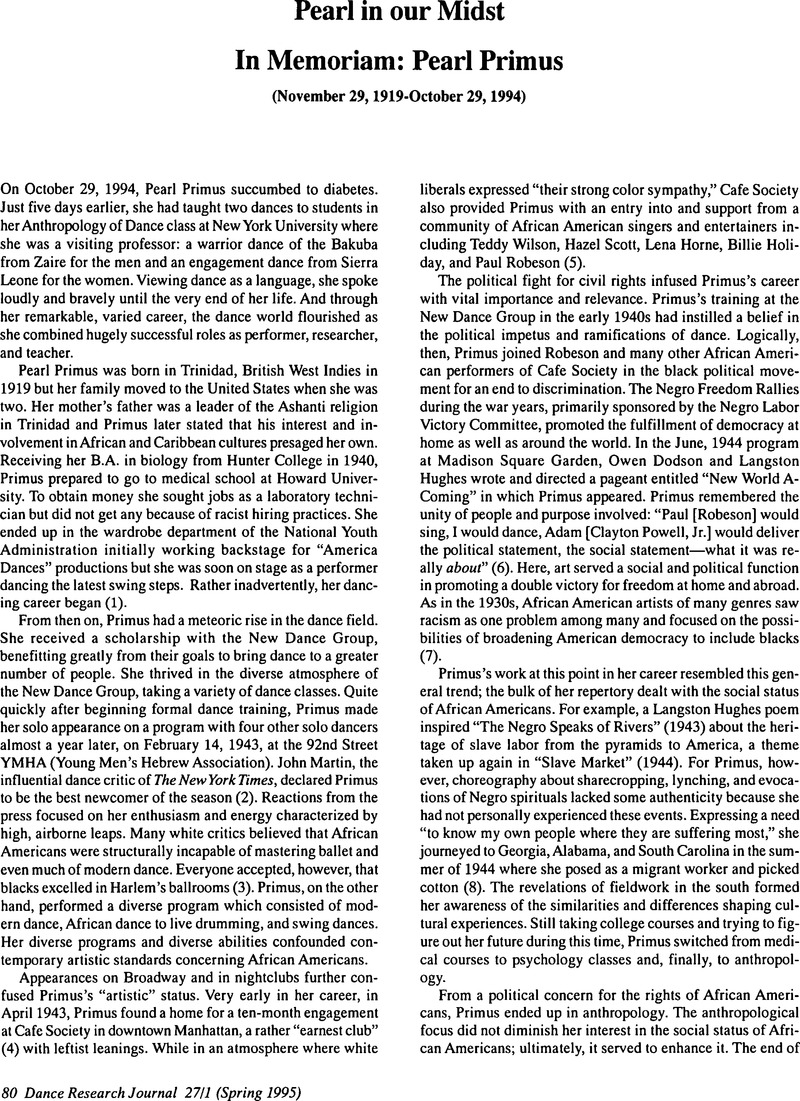No CrossRef data available.
Article contents
Pearl Primus: Pearl in our Midst
Published online by Cambridge University Press: 22 July 2014
Abstract

- Type
- In memoriam
- Information
- Copyright
- Copyright © Congress on Research in Dance 1995
References
Notes
1. Four dissertations discuss Primus: Barber, Beverly Anne Hillsman, “Pearl Primus, In Search of Her Roots: 1943–1970,” Florida State University (1984);Google ScholarPerpener, John O. III, “The Seminal Years of Black Concert Dance,” New York University (1992)Google Scholar; Creque-Harris, Leah, “The Representation of African Dance on the Concert Stage: From the Early Black Musical to Pearl Primus,” Emory University (1991);Google ScholarBegho, Felix O., “Black Dance Continuum: Reflections on the Heritage Connection Between African Dance and Afro-American Jazz Dance,” New York University (1984).Google Scholar See also: Martin, John, John Martin's Book of the Dance (NY: Tudor Publishing Company, 1963), 182–3;Google ScholarLloyd, Margaret, The Borzoi Book of Modern Dance (NY: Knopf, 1949), 268Google Scholar; Current Biography (1944), 551.
2. The New York Times (5 August 1943).
3. As one African American dance instructor of the Hampton Institute put it: everyone recognizes “the existence in abundance of great native capacity [in dance] among Negro youth” (Dance Observer v.4 #8 [October 1937]: 97–8). White critics more often qualified African Americans' “natural” dance capacity: for instance, “Everybody who knows the Negro at all, knows that he is a master of the cruder forms of dancing”(Lorant, Michael, “Hampton Institute: Negro's Unique Dancing Academy,” The Dancing Times [October 1938]: 20–1).Google Scholar See Martin, John op. cit. for an example of a critic's view about African Americans attempting ballet.Google Scholar
4. Denby, Edwin, Looking at the Dance (NY: Pellegrini & Cudahy, 1949), 377–8.Google Scholar
5. Dance Observer vol. 11 no. 9 (November 1944): 110.
6. Program of the 1944 Negro Freedom Rally in the Archives & Manuscripts Division of the Schomburg Research Center for Black Culture, New York Public Library; Primus quoted in Dekle, Nicole, “Pearl Primus: Spirit of the People,” Dance Magazine vol. 64 no. 12 (December 1990): 62–5. Italics original.Google Scholar
7. Randall, Dudley, “The Black Aesthetic in the '30s, '40s, and '50s,” in The Black Aesthetics, ed. Gayle, Addison Jr. (NY: Doubleday, 1971), 220.Google Scholar
8. Dance Magazine (April 1946): 30–1, 55–6; Lloyd, 274; Ebony vol. 6 no. 3 (January 1951): 54–8. Quote, Ebony: 56.
9. Dance Magazine vol. 24 no. 7 (July 1950): 21–3.
10. Primus, , “Africa Dances,” Dance Observer vol. 16 no. 10 (December 1949): 147.Google Scholar This is a letter from Primus, dated 28 September 1949, from Kahnplay, Liberia.
11. Primus, Pearl, “African Dance,” in African Heritage, ed. Drachler, Jacob (NY: Crowell-Cllier Press, 1963), 172–80Google Scholar; Dance Observer vol. 17 no. 9 (November 1950): 138; Dance Magazine vol. 24 no. 17 (July 1950): 21–3.
12. Personal correspondance from Primus to Walter Sorell, dated 30 March 1951, from New York City. Manuscript, Dance Collection, NYPL.
13. Dance Observer vol. 16 no. 10 (December 1949): 147.
14. Torgovnick, Marianna, Gone Primitive: Savage Intellects, Modern Lives (Chicago: University of Chicago Press, 1990), 11.Google Scholar
15. Dance Magazine vol. 38 no. 10 (October 1964): 20–1.
16. Primus, quoted in Dance Magazine vol. 42 no. 11 (November 1968): 56–60.Google Scholar


